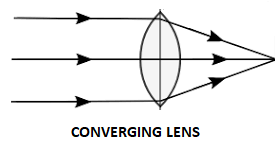
A small bulb is placed at the focal point of a converging lens. When the bulb is switched on, the lens produces:
A) a convergent beam of light
B) a divergent beam of light
C) a parallel beam of light
D) a patch of coloured
Answer
219.3k+ views
Hint: In general, there are two types of lens, they are converging lens and diverging lens. Both lenses are used for transmitting the light rays and also used for human eye lenses for correcting the eye disorder. Converging lens is also called a positive lens and the diverging lens is also called a negative lens.
Complete step by step solution:
Converging lens:
Converging lens is a lens which is used for transmitting the light to the focus area. The converging lens is also known as convex lens. This lens is thicker at the centre of the lens than the edge of the lens. The function of the convex lens is, when the parallel rays of light are allowed to pass through the lens, the refracted rays converge which means the refracted light rays will meet in the same point, that point is called the principal focus point. And the function of the converging lens or convex lens is reversed also. For example, when the bulb is placed near the convex lens or converging lens, it will refract the light rays, and the refracted light rays are parallel to each other.

Thus, a small bulb is placed near the converging lens, and the bulb is switched on, which produces the parallel beam of light.
Hence, the option (C) is the correct answer.
Note: If the lens is very thicker at the centre than the both edges of the lens, then it is a converging lens or convex lens. And it is also called a positive lens because it is having a positive focal length. If the lens is thin at the centre than the both edges of the lens, then it is a diverging lens or concave lens. And it is also called a negative lens because it is having negative focal length.
Complete step by step solution:
Converging lens:
Converging lens is a lens which is used for transmitting the light to the focus area. The converging lens is also known as convex lens. This lens is thicker at the centre of the lens than the edge of the lens. The function of the convex lens is, when the parallel rays of light are allowed to pass through the lens, the refracted rays converge which means the refracted light rays will meet in the same point, that point is called the principal focus point. And the function of the converging lens or convex lens is reversed also. For example, when the bulb is placed near the convex lens or converging lens, it will refract the light rays, and the refracted light rays are parallel to each other.

Thus, a small bulb is placed near the converging lens, and the bulb is switched on, which produces the parallel beam of light.
Hence, the option (C) is the correct answer.
Note: If the lens is very thicker at the centre than the both edges of the lens, then it is a converging lens or convex lens. And it is also called a positive lens because it is having a positive focal length. If the lens is thin at the centre than the both edges of the lens, then it is a diverging lens or concave lens. And it is also called a negative lens because it is having negative focal length.
Recently Updated Pages
A square frame of side 10 cm and a long straight wire class 12 physics JEE_Main

The work done in slowly moving an electron of charge class 12 physics JEE_Main

Two identical charged spheres suspended from a common class 12 physics JEE_Main

According to Bohrs theory the timeaveraged magnetic class 12 physics JEE_Main

ill in the blanks Pure tungsten has A Low resistivity class 12 physics JEE_Main

The value of the resistor RS needed in the DC voltage class 12 physics JEE_Main

Trending doubts
JEE Main 2026: Application Form Open, Exam Dates, Syllabus, Eligibility & Question Papers

Understanding Uniform Acceleration in Physics

Derivation of Equation of Trajectory Explained for Students

Hybridisation in Chemistry – Concept, Types & Applications

Understanding the Angle of Deviation in a Prism

Understanding Collisions: Types and Examples for Students

Other Pages
JEE Advanced Marks vs Ranks 2025: Understanding Category-wise Qualifying Marks and Previous Year Cut-offs

Understanding Atomic Structure for Beginners

How to Convert a Galvanometer into an Ammeter or Voltmeter

Understanding Centrifugal Force in Physics

JEE Main Marking Scheme 2026- Paper-Wise Marks Distribution and Negative Marking Details

Degree of Dissociation: Meaning, Formula, Calculation & Uses




